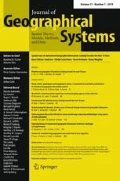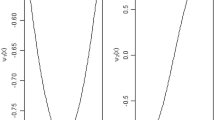Abstract
The quality of modeling results in GIS operations depends on how well we can track error propagating from inputs to outputs. Monte Carlo simulation, moment design and Taylor series expansion have been employed to study error propagation over the years. Among them, first-order Taylor series expansion is popular because error propagation can be analytically studied. Because most operations in GIS are nonlinear, first-order Taylor series expansion generally cannot meet practical needs, and higher-order approximation is thus necessary. In this paper, we employ Taylor series expansion methods of different orders to investigate error propagation when the random error vectors are normally and independently or dependently distributed. We also extend these methods to situations involving multi-dimensional output vectors. We employ these methods to examine length measurement of linear segments, perimeter of polygons and intersections of two line segments basic in GIS operations. Simulation experiments indicate that the fifth-order Taylor series expansion method is most accurate compared with the first-order and third-order method. Compared with the third-order expansion; however, it can only slightly improve the accuracy, but on the expense of substantially increasing the number of partial derivatives that need to be calculated. Striking a balance between accuracy and complexity, the third-order Taylor series expansion method appears to be a more appropriate choice for practical applications.




Similar content being viewed by others
References
Anderson TV, Mattson CA, Larson BJ, Fullwood DT (2012) Efficient propagation of error through system models for functions common in engineering. J Mech Des 134(1):1–6
Brown JD, Heuvelink GBD (2007) The Data Uncertainty Engine (DUE): a software tool for assessing and simulating uncertain environmental variables. Comput Geosci 33(2):172–190
Dettinger MD, Wilson JL (1981) First order analysis of uncertainty in numerical models of groundwater flow. Water Resour Res 17(1):149–161
Goodchild MF (2004) A general framework for error analysis in measurement-based GIS. J Geogr Syst 6(4):323–324
Helton JC, Davis FJ (2003) Latin hypercube sampling and the propagation of uncertainty in analyses of complex systems. Reliab Eng Syst Saf 81(1):23–69
Herrador MA, Asuero AG, Gonzalez AG (2005) Estimation of the uncertainty of indirect measurements from the propagation of distributions by using the Monte-Carlo method: an overview. Chemom Intell Lab Syst 79(1–2):115–122
Heuvelink GBM (1998) Error propagation in environmental modelling with GIS. Taylor & Francis, London
Heuvelink GBM, Burrough PA (1989) Propagation of errors in spatial modeling with GIS. Int J Geogr Inf Syst 3(4):303–322
Heuvelink GBM, Brown JD, van Loon EE (2007) A probabilistic framework for representing and simulating uncertain environmental variables. Int J Geogr Inf Sci 21(5):49–513
Jones L (1989) Some results comparing Monte Carlo simulation and first order Taylor series approximation for steady groundwater flow. Stoch Hydrol Hydraul 3(3):179–190
Kobayashi T, Miller HJ, Othman W (2011) Analytical methods for error propagation in planar space-time prisms. J Geogr Syst 13(4):327–354
Kuijpers B, Miller HJ, Neutens T, Othman W (2010) Anchor uncertainty and space-time prisms on road networks. Int J Geogr Inf Sci 24(8):1223–1248
Kuo W, Uppuluri VRR (1983) A review of error propagation analysis in systems. Microelectron Reliab 23(2):235–248
Leung Y, Ma JH, Goodchild MF (2004a) A general framework for error analysis in measurement-based GIS, Part 1: the basic measurement-error model and related concepts. J Geogr Syst 6(4):325–354
Leung Y, Ma JH, Goodchild MF (2004b) A general framework for error analysis in measurement-based GIS, Part 2: the algebra-based probability model for point-in-polygon analysis. J Geogr Syst 6(4):355–379
Leung Y, Ma JH, Goodchild MF (2004c) A general framework for error analysis in measurement-based GIS, part 3: error analysis in intersections and overlays. J Geogr Syst 6(4):381–402
Leung Y, Ma JH, Goodchild MF (2004d) A general framework for error analysis in measurement-based GIS, part 4: error analysis in length and area measurements. J Geogr Syst 6(4):403–428
Tukey JW (1956) The propagation of errors, fluctuations, and tolerances. Technical Report, Statistical Techniques Research Group, Princeton University
Wang MR (2003) MATLAB and scientific computing. Publishing House of Electronics Industry, Beijing
Xue J and Ma JH (2012) A comparative study of several Taylor expansion methods on error propagation. Proc 20th Int Conf Geoinformatics (IEEE GRSS), Hong Kong
Zhang JF (2006) The calculating formulae and experimental methods in error propagation analysis. IEEE Trans Reliab 55(2):169–181
Acknowledgments
This research was supported by the earmarked grant CU446213 of the Hong Kong Research Grant Council and the Geographical Modeling and GeoComputation Program under the Focused Innovation Scheme of The Chinese University of Hong Kong.
Author information
Authors and Affiliations
Corresponding author
Rights and permissions
About this article
Cite this article
Xue, J., Leung, Y. & Ma, JH. High-order Taylor series expansion methods for error propagation in geographic information systems. J Geogr Syst 17, 187–206 (2015). https://doi.org/10.1007/s10109-014-0207-x
Received:
Accepted:
Published:
Issue Date:
DOI: https://doi.org/10.1007/s10109-014-0207-x
Keywords
- Error propagation
- Geographic information system
- Taylor series expansion method
- Length measurement
- Intersection operation




